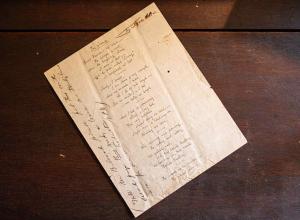Illuminating Faith: The Eucharist in Medieval Life and Art at the Morgan Library
New York, NY, April 4, 2013—When Christ changed bread and wine into his body and blood at the Last Supper, he instituted the Eucharist and established the central act of Christian worship. For medieval Christians, the Eucharist (the sacrament of Communion) was not only at the heart of the Mass—its presence and symbolism also wielded enormous influence over cultural and civic life. Illuminating Faith: The Eucharist in Medieval Life and Art, on view May 17 to September 2, 2013, explores how artists of the period depicted the celebration of the sacrament and its powerful hold on society in more than sixty-five exquisitely illuminated manuscripts drawn from the Morgan’s renowned collection.
Included among the masterpieces will be the Hours of Cardinal Alessandro Farnese, one of the greatest of all illuminated manuscripts; the Preparation for Mass of Pope Leo X, which remained at the Vatican until it was looted by Napoleon’s troops in 1798; a personal prayer book created for Anne de Bretagne, queen of France; and a number of superb Missals that are rarely exhibited. In addition, objects used in medieval Eucharistic rituals will be displayed, including a chalice, ciborium, pax, altar card, and two monstrances that displayed Communion wafers.
Illuminating Faith is divided into six thematic sections, and features works from France, Italy, and the Netherlands, as well as from Belgium, Germany, and Hungary. Positioned at the center of the gallery will be a replica of a rood screen—a pierced wooden enclosure that separated the clergy from the congregation in medieval churches. The exhibition is accompanied by a complimentary audio guide and an online lecture, both narrated by exhibition curator Roger Wieck.
Institution of the Eucharist
At the Last Supper, the night before he died, Jesus took bread, blessed and broke it, and gave it to his apostles, saying, “Take and eat, this is my body.” He then took a cup of wine, blessed it, and gave it to them, saying, “All of you drink this, for this is my blood of the new covenant, which is being shed for many for the forgiveness of sins.” Finally, Jesus commissioned the apostles to “Do this in memory of me.”
By changing the substance of the bread and wine into his body and blood—called Transubstantiation—Christ instituted the Eucharist. The Last Supper was the first Mass, the apostles the first priests, and at each Mass thereafter Christians have participated in the reenactment of that historic event. Illuminating Faith includes numerous depictions of the institution of the Eucharist at the Last Supper. These manuscripts often combine biblical imagery with medieval liturgical practice—a cup of wine looks like a chalice; a loaf of bread resembles a Communion wafer; Jesus’s gestures evoke the actions of a priest.
In addition to its ties to the Last Supper, the Eucharist is inextricably linked to Christ’s Passion and death on the Cross. Although the significance of Christ’s blood was established at the Last Supper, its prominence in illuminated manuscripts was heightened as the late Middle Ages progressed and depictions of the Passion became increasingly bloodier. Several works on view depict angels using chalices to collect the blood dripping from Christ’s wounds. Others highlight its salvific effects, such as a fifteenth-century Italian illumination showing Christ’s blood dripping down the shaft of the Cross onto the skull of Adam, thereby cleansing it and redeeming all of mankind from Original Sin.
Celebration of Mass
The most important act of medieval Christian worship was the Eucharistic sacrifice of the Mass. However, men and women attending Mass in the Middle Ages had, at times, little to see and not much to hear. The priest kept his back to the congregation and whispered the Mass in Latin. However, when the Fourth Lateran Council in 1215 codified Transubstantiation and decreed that everyone was required to receive Communion at least once a year, a new ritual was introduced: after consecrating the Eucharistic wafer, the priest would raise it high above his head for all to see. This elevation of the Eucharist—lit by candles and announced by ringing bells—became the climax of each Mass. As people in the Middle Ages generally received Communion only once a year (around Easter), seeing the consecrated host became a substitute. Indeed, it was not unusual for Christians of the time to run from church to church to see as many Elevations as possible.
This section of the exhibition includes exceptional examples of Missals used by medieval priests to ensure accurate gestures, actions, and recitation of prayers while celebrating Mass. Works on display range from an unusual Missal containing nearly thirty miniatures illustrating individual actions of the priest, to a book from Cambridge that escaped being destroyed after the establishment of the Church of England, to a lavish Missal painted by Jean Poyer, one of France’s foremost early Renaissance artists.
Also presented are a number of objects used to protect and contain the Eucharist. Chalices—which hold the consecrated wine at Mass—are considered the most important Eucharistic objects because they symbolize the sacrificial cup of the Last Supper. Because of their sacred function, they were often made of the most precious materials, as is the fourteenth-century silver gilt and enameled example on view. Also on display is an elaborate pax, a hand-held liturgical object which would have been kissed by the priest before being offered to the congregation for them, too, to kiss. A ciborium is a vessel used to house multiple Communion wafers, before or after their consecration. The exceptional early-fourteenth-century Austrian ciborium in the exhibition is lockable, following the wishes expressed by the Fourth Lateran Council of 1215. Monstrances, unlike ciboria, display only one host. Illuminating Faith features two monstrances, both on loan from the Metropolitan Museum of Art.
Standing at the center of the gallery will be a replica of a wooden rood screen—so called because it was typically surmounted by a cross or crucifix, called a rood in Old English. These screens preserved and framed the mystery of the Eucharist by separating the chancel, where the clergy celebrated Mass, from the nave, where the congregation gathered.
The Eucharist and the Old Testament
The third section of the exhibition explores typology—the theological study of “types.” Types were people, events, or things from the Old Testament interpreted by medieval theologians as foreshadowing or prefiguring people, events, or things of the New Testament. Thus, the Eucharist—interpreted as the New Law and succeeding the Old Law of Moses—was insured a rich array of typological references.
A page from the Hours of Catherine of Cleves, for example, depicts the Israelites gathering manna in the desert. Manna, the miraculous food provided by God to the Israelites on their journey from Egypt to the Holy Land, was regarded as a prefiguration of the Eucharist. The page is framed by several biblical quotations that explain the typological relationship, including, “This is my body which I have given to you.”
A mid-fifteenth-century Belgium manuscript relates Christ’s institution of the Eucharist at the Last Supper with a number of Old Testament types, including the gathering of manna, Jews eating the paschal lamb at Passover, and Melchizedek offering bread and wine to Abraham following his victories.
Domestic Devotion to the Eucharist
The Eucharist had always been the heart of the Mass, but in the high and late Middle Ages, the Eucharistic wafer became the focus—and its Elevation by the priest at Mass the climax of the ceremony. Viewing the host was not only good for the soul, it was also thought to help avert evil, capable of protecting one from blindness or sudden death, for instance. During this era the wafer achieved cult-like status, and lay people were provided with opportunities to worship the host outside of Mass at expositions and processions.
Illuminating Faith is particularly rich in private prayer books for the laity, especially Books of Hours. These works, which included Eucharistic prayers to be said at home or at church when receiving Communion or simply viewing it, provide fascinating glimpses into how the fervor with which the Eucharist was regarded effected personal devotion. Of particular note is a precious prayer book commissioned by Anne de Bretagne, queen of France, to teach her son, the dauphin Charles-Orland, his basic catechism. In addition to prayers Anne taught the dauphin to memorize, the book contains prayers that he was to read on his own as he grew up. Sadly, Charles-Orland died shortly after his third birthday, soon after the book was made.
Feast of Corpus Christi
In the thirteenth century, a nun, Blessed Juliana, dreamt of a full moon marred by a dark blemish. Christ himself, she said, later revealed the symbolism of this Eucharistic vision to her: the moon represented the Church and the blemish the absence of a feast celebrating the Eucharist. Largely at Juliana’s instigation, the Feast of Corpus Christi—celebrating the institution of the Eucharist and, by extension, God’s gift of his son to humankind—was first established in Liège, Belgium, in 1246, before spreading to the universal Church.
Corpus Christi was celebrated throughout medieval and Renaissance Europe by its own Mass, special indulgences, mystery plays, expositions of the sacrament, and—the great hallmark of the feast—elaborate processions through city streets specially decorated for the occasion. Over the course of an entire week, laypeople had many opportunities to worship an exposed host. In an age when the laity received communion but once a year, and could catch only fleeting glimpses of a host when elevated at Mass, the week-long feast provided people with the chance to spend hour after hour in adoration. Anyone who viewed the host during a procession and prayed an Our Father or a Hail Mary could be relieved of their sins, and the indulgence increased if the devotee had confessed before the procession or if he bore a torch.
Works on display speak to the feast’s eventual popularity and geographic reach, with examples from France, Belgium, Hungary, and Italy. The Morgan’s three prayer books from thirteenth-century Liège, the century and city that gave birth to Corpus Christi, are among the earliest manuscripts on view. The latest is the Hours of Cardinal Alessandra Farnese, a sixteenth-century Italian masterpiece illuminated by Giulio Clovio. At the center of the grand Corpus Christi procession illustrated in the two-page spread on view sits Pope Paul III, grandfather of Cardinal Farnese. As the procession winds its way into Old St. Peter’s Basilica, putti descend from heaven carrying baskets of flowers representing forgiving grace.
Eucharistic Miracles
The dichotomy between the Eucharist’s unassuming appearance (a flat piece of white bread) and what it was (the sacrificed body of Jesus) often presented to medieval Christians a challenge of faith. Most Eucharistic miracles of the Middle Ages treated the faithful to a clearer demonstration or vision of Christ’s True Presence in the Communion host.
Bleeding Hosts were the most convincing miracles that revealed—literally—the True Presence of Christ in the Eucharist. Communion wafers that miraculously bled were especially numerous in the late Middle Ages and became the focus of popular cults and pilgrimages. Bleeding hosts also resulted in Jewish persecution—the dark flip side of medieval Eucharistic devotion. In a manuscript illuminated for Queen Eleanor of Portugal, for instance, Anthony of Padua attempts to convince a Jew of the real presence of Christ in the Eucharist by presenting to a hungry mule a communion wafer and a container of oats. According to the legend, the animal ignored its feed and knelt before the host in recognition of its true essence.
Of the many medieval communion wafers that oozed Christ’s blood, the Sacred Bleeding Host of Dijon was the most visually arresting. Embossed with an image of Christ flanked by the instruments of his Passion, the Host bled at the Savior’s hands, knees, and feet, and at the nails, spear, Cross, and Crown of Thorns. A perimeter circle of blood made the host look as if it had been pierced with a miniature Crown of Thorns. Tradition held that the Dijon Host, like most bloody hosts in the Middle Ages, was caused by Jewish desecration. Exhibition curator Roger Wieck is the world expert on the Dijon host.
In 1433 the Host was given by Pope Eugenius IV to Duke Philip of Burgundy, who installed it in the chapel of his ducal palace in Dijon. The wafer became the focus of an ardent cult immediately after its arrival in Dijon, quickly becoming the city’s holy mascot, and credited with saving it in times of war, plague, and drought. After King Louis XII’s health was restored after he prayed to the Host in 1505, the cult spread to Paris.
The cult of the Dijon Host flourished for over 350 years, well into the eighteenth century. Since hosts normally crumble into dust over time, the Host’s centuries-long survival was considered miraculous in itself. A 1753 printed book on display contains what is possibly the last known image of the Host (French Revolutionaries publicly burned it in 1794). In the nineteenth century, the mystery of the bloody host was solved. The fungus, micrococcus prodigiosus, a microscopic organism, was identified. Growing on bread, it turns red and liquefies, creating the “blood” on miraculous wafers.
PUBLIC PROGRAMS
LECTURES & DISCUSSIONS
- The Sacred Bleeding Host of Dijon
In 1433, Pope Eugenius IV gave Duke Philip the Good of Burgundy a Communion wafer embossed with an image of Christ as Judge that miraculously bled. Roger S. Wieck, curator of Illuminating Faith, discusses the fascinating 350-year history of the Sacred Bleeding Host of Dijon. The exhibition will be open until 9 pm.
Free; Advance reservations suggested: tickets@themorgan.org
- A Conversation with Thomas Lanigan-Schmidt
Wednesday, June 12, 7 pm
New York artist Thomas Lanigan-Schmidt and Roger S. Wieck, curator of Illuminating Faith, discuss the art of transubstantiation and the religious symbolism in Lanigan-Schmidt’s mixed-media constructions, which contain cheap and ephemeral materials to make icons, chalices, and altarpieces. Illuminating Faith will be open at 6 pm for program attendees.
Free; Advance reservations suggested: tickets@themorgan.org
FILMS
- Perspectives of Faith on Film
The Bells of St. Mary
Friday, June 14, 7 pm
(1945, 126 minutes)
Director: Leo McCarey
Bing Crosby reprises his Oscar-winning role as Father Charles “Chuck” O’Malley, an unconventional Catholic priest who must work with the staunch but stubborn Sister Mary Benedict (Ingrid Bergman), to save a dilapidated school in St. Mary’s parish. Also starring Henry Travers as Mr. Horace P. Bogardus, a businessman whose neighboring building may solve their problems.
Free with museum admission. Tickets are available at the Admission Desk on the day of the screening.
- Babette’s Feast
Friday, June 28, 7 pm
(1987, 102 minutes)
Director: Gabriel Axel
In 19th-century Denmark, the sheltered Protestant community of Martine and Philippa, spinster daughters of the now-deceased founding pastor, is disrupted when Frenchwoman Babette Hersant seeks refuge bearing a connection to their past. The sisters employ her as a housekeeper for fourteen years, little knowing that Babette would bestow a tremendous gift on the 100th anniversary of their father’s birth.
Free with museum admission. Tickets are available at the Admission Desk on the day of the screening.
GALLERY TALK
- Illuminating Faith: The Eucharist in Medieval Life and Art
Roger S. Wieck, Curator of Medieval and Renaissance Manuscripts, will lead this informal look at the exhibition.
Free with admission
BETWEEN THE LINES
- Illuminating Faith: The Eucharist in Medieval Life and Art
Written or drawn, lines are to be read and interpreted. In this interactive gallery talk, a museum educator leads participants in an hour-long discussion on a selection of works from Illuminating Faith.
Free with admission; Space is limited on a first-come, first-served basis.
Sponsorship
Illuminating Faith is organized by Roger Wieck, Curator of Medieval and Renaissance Manuscripts at The Morgan Library & Museum.
This exhibition is made possible by Virginia M. Schirrmeister, with further generous support from the Janine Luke and Melvin R. Seiden Fund for Exhibitions and Publications, and from James Marrow and Emily Rose.
The programs of the Morgan Library & Museum are made possible with public funds from the New York City Department of Cultural Affairs in partnership with The City Council, and by the New York State Council on the Arts with the support of Governor Andrew Cuomo and the New York State Legislature.
The Morgan Library & Museum
The Morgan Library & Museum began as the private library of financier Pierpont Morgan, one of the preeminent collectors and cultural benefactors in the United States. Today, more than a century after its founding in 1906, the Morgan serves as a museum, independent research library, musical venue, architectural landmark, and historic site. In October 2010, the Morgan completed the first-ever restoration of its original McKim building, Pierpont Morgan’s private library, and the core of the institution. In tandem with the 2006 expansion project by architect Renzo Piano, the Morgan now provides visitors unprecedented access to its world-renowned collections of drawings, literary and historical manuscripts, musical scores, medieval and Renaissance manuscripts, printed books, and ancient Near Eastern seals and tablets.
General Information
The Morgan Library & Museum
225 Madison Avenue, at 36th Street, New York, NY 10016-3405
212.685.0008
www.themorgan.org
Just a short walk from Grand Central and Penn Station
Hours
Tuesday-Thursday, 10:30 a.m. to 5 p.m.; extended Friday hours, 10:30 a.m. to 9 p.m.; Saturday, 10 a.m. to 6 p.m.; Sunday, 11 a.m. to 6 p.m.; closed Mondays, Thanksgiving Day, Christmas Day, and New Year’s Day. The Morgan closes at 4 p.m. on Christmas Eve and New Year’s Eve.
Admission
$15 for adults; $10 for students, seniors (65 and over), and children (under 16); free to Members and children 12 and under accompanied by an adult. Admission is free on Fridays from 7 to 9 p.m. Admission is not required to visit the Morgan Shop.
















